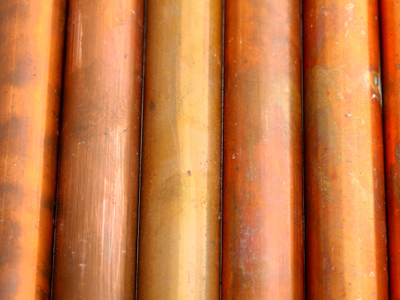
Copper is a metal that does not react with water or steam. This means it is a good metal for water pipes.
Reactions, Equations and Formulae 01
This is an enjoyable way to test your knowledge about chemical reactions. What are reactants?
Between the ages of 11 and 14 our quizzes are invaluable.
Scroll down to play the quiz
1 .
Which of the following metals is the most reactive with acids?
Aluminium
Iron
Magnesium
Zinc
When a reactive metal reacts with dilute strong acids, hydrogen is produced
2 .
The formula for calcium hydroxide is Ca(OH)2. This means it contains:
1 calcium atom, 1 oxygen atom, 2 hydrogen atoms
1 calcium atom, 2 oxygen atoms, 1 hydrogen atom
1 calcium atom, 2 oxygen atoms, 2 hydrogen atoms
2 calcium atoms, 2 oxygen atoms, 2 hydrogen atoms
Multiply everything inside the bracket by the number outside - just the same as you would do in maths
3 .
In the following reaction which are the products Mg + 2HCl → H2 + MgCl2?
Hydrochloric acid and magnesium chloride
Hydrogen and magnesium chloride
Magnesium and hydrochloric acid
Magnesium and hydrogen
Metal plus acid gives hydrogen and a salt
4 .
Which of the following is the correct balanced equation for the reaction between copper with oxygen from the air?
2 Cu + O2 → Cu2O2
2 Cu + O2 → 2 CuO
Cu + O → CuO
Cu + O2 → CuO2
There should be exactly the same number of each atom on both sides of an equation otherwise it has not been written down correctly AND all the formulae should be correct. Answers 1 and 4 look OK but the formula for copper oxide is wrong. Answer 3 also seems balanced, but the formula for oxygen from the air is O2 and not O
5 .
During a chemical reaction new substances are formed from old ones. Which of the following is NOT ALWAYS true?
New substances can be changed back to the original ones
The total mass of products = total mass of reactants
There is often a colour change
There is often a temperature change
Most chemical changes are not reversible under normal conditions
6 .
2H2SO4 means 2 molecules of sulfuric acid. They contain:
2 hydrogen atoms, 1 sulfur atom, 4 oxygen atoms
4 hydrogen atoms, 1 sulfur atom, 4 oxygen atoms
4 hydrogen atoms, 2 sulfur atoms, 8 oxygen atoms
4 hydrogen atoms, 4 sulfur atoms, 8 oxygen atoms
Each molecule contains 2 hydrogen atoms, 1 sulfur atom, 4 oxygen atoms but the '2' in front of the formula means that there are two molecules so you need to double everything to get the right answer
7 .
The formula for potassium nitrate is KNO3. This means it contains:
1 potassium atom, 1 nitrogen atom, 3 oxygen atoms
1 potassium atom, 3 nitrogen atoms, 3 oxygen atoms
3 potassium atoms, 3 nitrogen atoms, 3 oxygen atoms
3 potassium atoms, 3 nitrogen atoms, 9 oxygen atoms
There are no small numbers written down after the symbols for potassium and nitrogen therefore there is only one atom of each of these elements. That immediately rules out the other three options as being the correct answer
8 .
Which of the following metals do NOT react with water or steam?
Aluminium
Copper
Tin
Zinc
Copper is low in the reactivity series
9 .
When zinc carbonate reacts with dilute hydrochloric acid the products are:
carbon dioxide, water
zinc chloride, carbon dioxide
zinc chloride, carbon dioxide, water
zinc sulfate, carbon dioxide, water
A carbonate + dilute acid always produces a salt + carbon dioxide + water
10 .
The formula for copper nitrate is Cu(NO3)2. This means it contains:
1 copper atom, 1 nitrogen atom, 6 oxygen atoms
2 copper atoms, 2 nitrogen atoms, 3 oxygen atoms
1 copper atom, 2 nitrogen atoms, 6 oxygen atoms
2 copper atoms, 2 nitrogen atoms, 6 oxygen atoms
Did you remember to multply everything inside the brackets by two?
**Unlimited Quizzes Await You! 🚀**
Hey there, quiz champ! 🌟 You've already tackled today's free questions.
Ready for more?
Ready for more?
🔓 Unlock UNLIMITED Quizzes and challenge yourself every day. But that's
not all...
not all...
🔥 As a Subscriber you can join our thrilling "Daily Streak" against other
quizzers. Try to win a coveted spot on our Hall of Fame Page.
quizzers. Try to win a coveted spot on our Hall of Fame Page.
Don't miss out! Join us now and keep the fun rolling. 🎉
**Unlimited Quizzes Await You! 🚀**
Hey there, quiz champ! 🌟 You've already tackled today's free questions. Ready for more?
🔓 Unlock UNLIMITED Quizzes and challenge yourself every day. But that's not all...
🔥 As a Subscriber you can join our thrilling "Daily Streak" against other quizzers. Try to win a coveted spot on our Hall of Fame Page.
Don't miss out! Join us now and keep the fun rolling. 🎉







